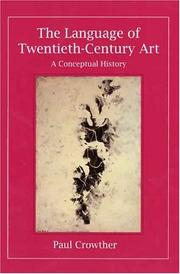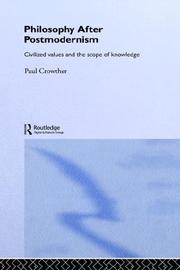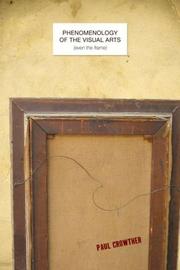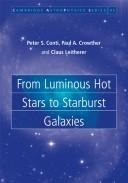| Listing 1 - 10 of 10 |
Sort by
|

ISBN: 0300072414 Year: 1997 Publisher: New Haven, Conn. Yale University Press
Abstract | Keywords | Export | Availability | Bookmark
 Loading...
Loading...Choose an application
- Reference Manager
- EndNote
- RefWorks (Direct export to RefWorks)
1 Iterability, Pictorial Representation and Beyond##2 The Structure of Cubism##3 Front Duration to Modernity: Bergson and Italian Futurism##4 Malevich, Philosophy and Non-Objectivity##5 Dialectic and Surrealism: From Breton to Pollock##6 The Dialectic of Abstract-Real in Mondrian##7 Barnett Newman and the Sublime##8 Aesthetic Ideas versus Conceptual Art##9 Simulation and Postmodern Representation##10 The Postmodern Iterable: Installation and Assemblage Art##11Leaving the Twentieth Century: A Future for Art

ISBN: 0415310369 Year: 2003 Volume: 16 Publisher: London New York Routledge
Abstract | Keywords | Export | Availability | Bookmark
 Loading...
Loading...Choose an application
- Reference Manager
- EndNote
- RefWorks (Direct export to RefWorks)
Connaissance [Théorie de la ] --- Epistemologie --- Epistemology --- Epistémologie --- Filosofie van het postmodernisme --- Kenleer --- Kennisleer --- Kennistheorie --- Kentheorie --- Knowledge [Theory of ] --- Philosophie postmoderniste --- Postmodernism --- Postmodernisme --- Postmodernisme (esthétique) --- Postmodernisme (filosofie) --- Postmodernisme (philosophie) --- Theorie of knowledge --- Theorievorming --- Théorie de la connaissance --- Valeurs (Philosophie) --- Values --- Waarden (Filosofie) --- Civilization --- Knowledge, Theory of --- Civilisation --- Philosophy --- Philosophie --- Théorie de la connaissance
Book
ISBN: 0198248482 128198907X 9786611989071 0191520039 9780198248484 Year: 1989 Publisher: Oxford : Clarendon press,
Abstract | Keywords | Export | Availability | Bookmark
 Loading...
Loading...Choose an application
- Reference Manager
- EndNote
- RefWorks (Direct export to RefWorks)
A monograph devoted exclusively to Kant's theory of the sublime a subject currently witnessing a revival amongst European philosphers in relation to debates about the nature of postmodernism.
Sublime, The --- Sublime --- History --- Histoire --- Kant, Immanuel, --- -Aesthetics --- Kant, Immanuel --- -Contributions in concept of the sublime --- -History --- History. --- Contributions in concept of the Sublime. --- Sublime, The - History - 18th century.
Book
ISBN: 1280577177 9786613606884 1441115064 9781441115065 9781441142580 1441142584 9781441130914 1441130918 9781441136077 144113607X Year: 2012 Publisher: New York : Continuum International Pub. Group,
Abstract | Keywords | Export | Availability | Bookmark
 Loading...
Loading...Choose an application
- Reference Manager
- EndNote
- RefWorks (Direct export to RefWorks)
As a philosophical approach, phenomenology is concerned with structure in how phenomena are experienced. The Phenomenology of Modern Art uses phenomenological insights to explain the significance of style in modern art, most notably in Impressionism, Expressionism, Cezanne and Cubism, Duchampian conceptualism and abstract art. Paul Crowther explores this thematic approachin a new way, addressing specific visual artworks and tendencies in detail and introduces a new methodology- post-analytic phenomenology. It is this more critical, post-analytic orientation that allows the book to utilise some
Art, Modern --- Phenomenology. --- Philosophy, Modern --- Affichistes (Group of artists) --- Fluxus (Group of artists) --- Modernism (Art) --- Schule der Neuen Prächtigkeit (Group of artists) --- Zero (Group of artists) --- Deleuze, Gilles, --- Deleuze, G. --- Delëz, Zhilʹ, --- Dūlūz, Jīl, --- دولوز، جيل --- Delezi, Jier,
Book
ISBN: 9780804798464 9780804795739 9780804798587 0804798583 0804795738 080479846X Year: 2016 Publisher: Stanford, California : Stanford University Press,
Abstract | Keywords | Export | Availability | Bookmark
 Loading...
Loading...Choose an application
- Reference Manager
- EndNote
- RefWorks (Direct export to RefWorks)
Despite the wonders of the digital world, people still go in record numbers to view drawings and paintings in galleries. Why? What is the magic that pictures work on us? This book provides a provocative explanation, arguing that some pictures have special kinds of beauty and sublimity that offer aesthetic transcendence. They take us imaginatively beyond our finite limits and even invoke a sense of the divine. Such aesthetic transcendence forges a relationship with the ultimate and completes us psychologically. Philosophers and theologians sometimes account for this as an effect of art, but How Pictures Complete Us distinguishes itself by revealing how this experience is embodied in pictorial structures and styles. Through detailed discussions of artworks from the Renaissance through postmodern times, Paul Crowther reappraises the entire scope of beauty and the sublime in the context of both representational and abstract art, offering unexpected insights into familiar phenomena such as ideal beauty, pictorial perspective, and what pictures are in the first place.
Aesthetics --- Painting --- Art, Modern --- Pictures --- Aesthetics, Modern. --- Art and religion. --- Art --- Arts in the church --- Religion and art --- Religion --- Modern aesthetics --- Iconography --- Pictorial representations --- Visual aids --- Modern art --- Nieuwe Ploeg (Group of artists) --- Philosophy. --- Religious aspects

ISBN: 9780199244973 0199244979 Year: 1993 Publisher: Oxford: Clarendon,
Abstract | Keywords | Export | Availability | Bookmark
 Loading...
Loading...Choose an application
- Reference Manager
- EndNote
- RefWorks (Direct export to RefWorks)
Publisher description:##In his Critical Aesthetics and Postmodernism, Paul Crowther argued that art and aesthetic experiences have the capacity to humanize. In Art and Embodiment he develops this theme in much greater depth, arguing that art can bridge the gap between philosophy's traditional striving for generality and completeness, and the concreteness and contingency of humanity's basic relation to the world. As the key element in his theory, he proposes an ecological definition of art. His strategy involves first mapping out and analyzing the logical boundaries and ontological structures of the aesthetic domain. He then considers key concepts from this analysis in the light of a tradition in Continental philosophy (notably the work of Kant, Heidegger, Merleau-Ponty, and Hegel) which--by virtue of the philosophical significance that it assigns to art--significantly anticipates the ecological conception. On this basis, Crowther is able to give a full formulation of his ecological definition. Art, in making sensible or imaginative material into symbolic form, harmonizes and conserves what is unique and what is general in human experience. The aesthetic domain answers basic needs intrinsic to self-consciousness itself, and art is the highest realization of such needs. In the creation and reception of art the embodied subject is fully at home with his or her environment.
Art --- Aesthetics.

ISBN: 0804772983 9780804772983 9780804762144 0804762147 Year: 2009 Publisher: Stanford, Calif. : Stanford University Press,
Abstract | Keywords | Export | Availability | Bookmark
 Loading...
Loading...Choose an application
- Reference Manager
- EndNote
- RefWorks (Direct export to RefWorks)
The book is a comprehensive phenomenological study of meanings that are unique to the major visual art forms.
Aesthetics. --- Art --- Phenomenology and art. --- Philosophy.
Multi
ISBN: 9783030422240 9783030422257 9783030422233 Year: 2021 Publisher: Cham Springer International Publishing
Abstract | Keywords | Export | Availability | Bookmark
 Loading...
Loading...Choose an application
- Reference Manager
- EndNote
- RefWorks (Direct export to RefWorks)
Modern businesses depend on data for their very survival, creating a need for sophisticated databases and database technologies to help store, organise and transport their valuable data. This updated and expanded, easy-to-read textbook/reference presents a comprehensive introduction to databases, opening with a concise history of databases and of data as an organisational asset. As relational database management systems are no longer the only database solution, the book takes a wider view of database technology, encompassing big data, NoSQL, object and object-relational, and in-memory databases. Presenting both theoretical and practical elements, the new edition also examines the issues of scalability, availability, performance and security encountered when building and running a database in the real world. Topics and features: Presents review and discussion questions at the end of each chapter, in addition to skill-building, hands-on exercises Provides new material on database adaptiveness, integration, and efficiency in relation to data growth Introduces a range of commercial databases and encourages the reader to experiment with these in an associated learning environment Reviews use of a variety of databases in business environments, including numerous examples Discusses areas for further research within this fast-moving domain With its learning-by-doing approach, supported by both theoretical and practical examples, this clearly-structured textbook will be of great value to advanced undergraduate and postgraduate students of computer science, software engineering, and information technology. Practising database professionals and application developers will also find the book an ideal reference that addresses today's business needs. Konstantinos Domdouzis is senior lecturer in the Communication and Computing Research Centre at Sheffield Hallam University, UK. Peter Lake (now retired) was formerly course leader for the Oracle IT&M MSc and the IT Professional MSc at Sheffield Hallam University. Paul Crowther (now retired) was formerly head of postgraduatetaught programmes in the Faculty of Arts, Computing, Engineering and Sciences at Sheffield Hallam University.
Mathematical control systems --- Information systems --- Computer. Automation --- informatica --- database management --- informatietechnologie --- software engineering --- informatietheorie

ISBN: 9780521791342 0521791340 9780511536199 9781107407732 9780511457494 0511457499 0511456182 9780511456183 9780511454455 0511454457 9780511455483 0511455488 1107194814 1281944815 9786611944810 0511453477 0511536194 Year: 2008 Publisher: Cambridge, UK ; New York : Cambridge University Press,
Abstract | Keywords | Export | Availability | Bookmark
 Loading...
Loading...Choose an application
- Reference Manager
- EndNote
- RefWorks (Direct export to RefWorks)
Luminous hot stars represent the extreme upper mass end of normal stellar evolution. Before exploding as supernovae, they live out their lives of a few million years with prodigious outputs of radiation and stellar winds, dramatically affecting both their evolution and environments. A detailed introduction to the topic, this book connects the astrophysics of massive stars with the extremes of galaxy evolution represented by starburst phenomena. A thorough discussion of the physical and wind parameters of massive stars is presented. HII galaxies, their connection to starburst galaxies, and the contribution of starburst phenomena to galaxy evolution through superwinds, are explored. The book concludes with the wider cosmological implications, including Population III stars, Lyman break galaxies and gamma-ray bursts, for each of which massive stars are believed to play a crucial role. This book is ideal for graduate students and researchers in astrophysics interested in luminous hot stars and galaxy evolution.
Starbursts --- Gamma ray bursts --- Stars --- Stellar winds --- Etoiles --- Vents stellaires --- Evolution --- Starbursts. --- Gamma ray bursts. --- Stellar winds. --- Winds, Stellar --- Space plasmas --- Stellar activity --- Stellar evolution --- Compact objects (Astronomy) --- Bursts, Cosmic gamma ray --- Bursts, Gamma ray --- Cosmic gamma ray bursts --- Transients, Gamma ray --- Gamma ray astronomy --- X-ray bursts --- Star bursts --- Starburst galaxies --- Evolution. --- Winds
Book
ISBN: 9783030422240 9783030422257 9783030422233 Year: 2021 Publisher: Cham Springer International Publishing :Imprint: Springer
Abstract | Keywords | Export | Availability | Bookmark
 Loading...
Loading...Choose an application
- Reference Manager
- EndNote
- RefWorks (Direct export to RefWorks)
Mathematical control systems --- Information systems --- Computer. Automation --- informatica --- database management --- informatietechnologie --- software engineering --- informatietheorie
| Listing 1 - 10 of 10 |
Sort by
|

 Search
Search Feedback
Feedback About UniCat
About UniCat  Help
Help News
News